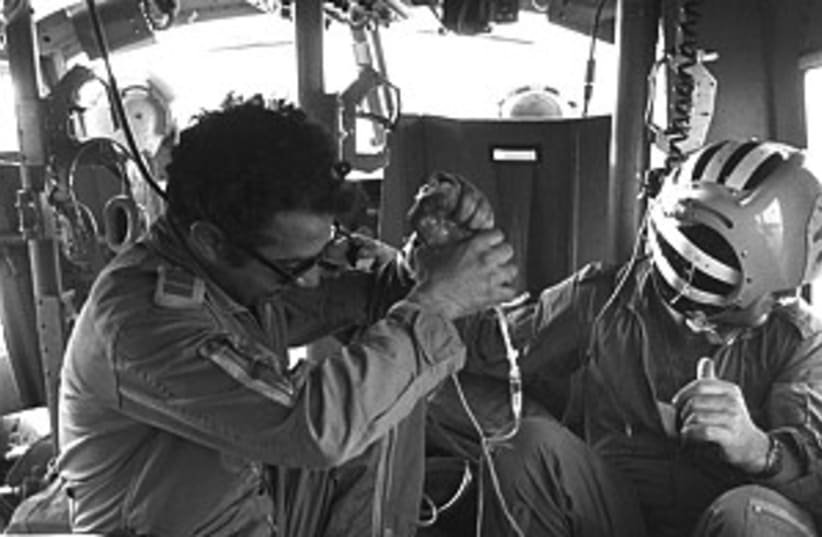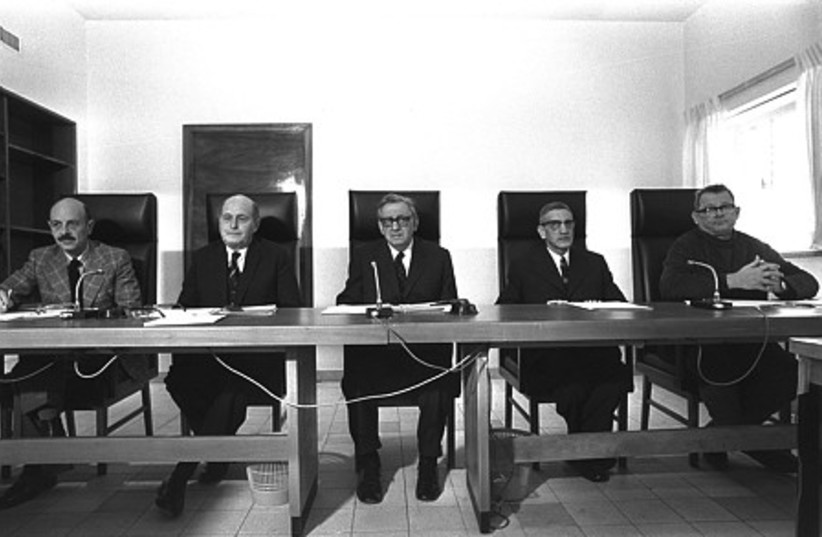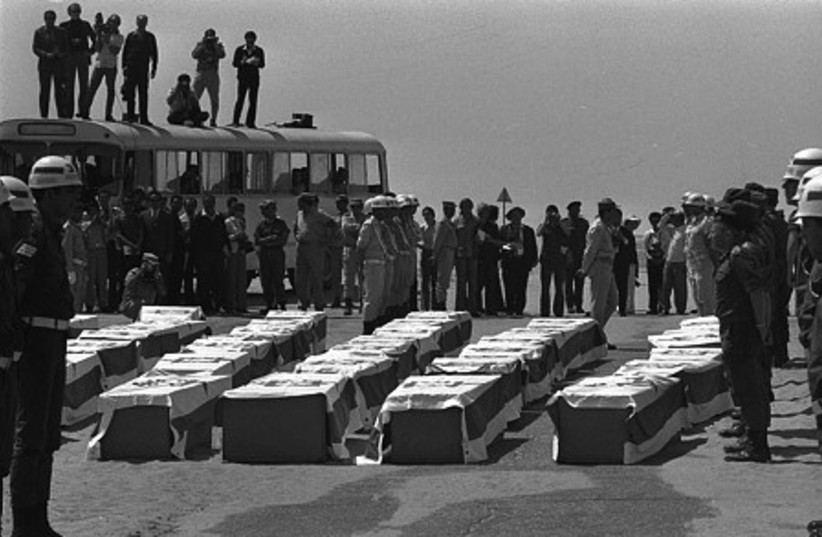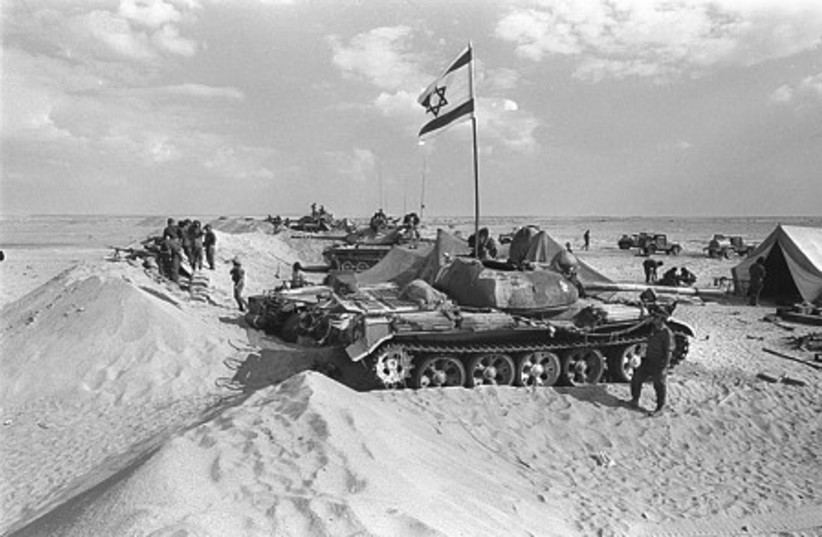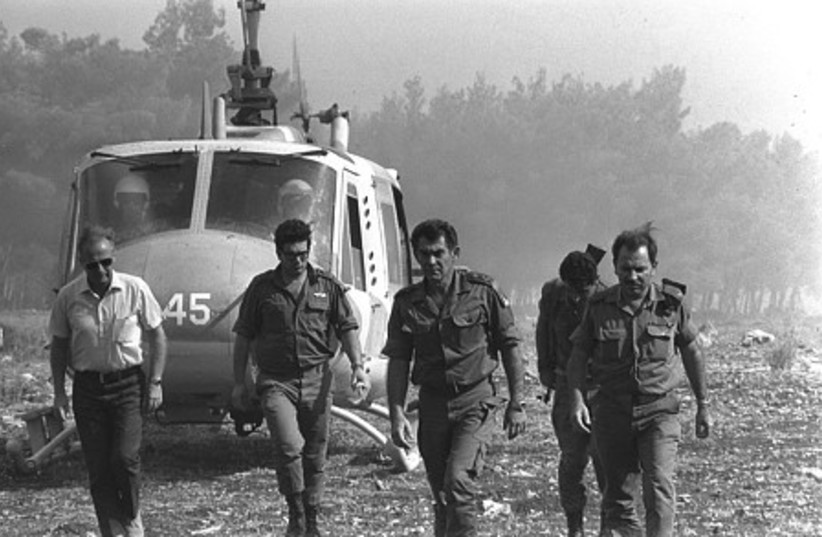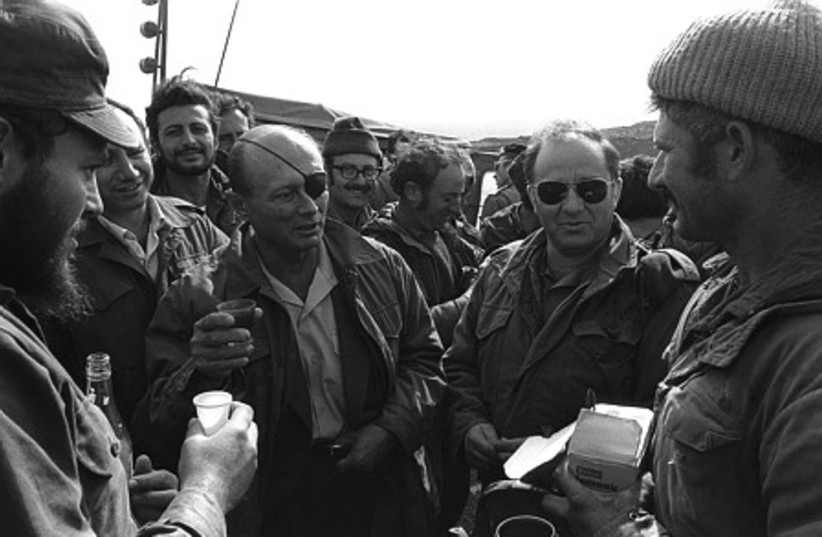It was born in trauma, ended in trauma and trauma would haunt its memory for years. With time, it would slip quietly into history and in an odd turning become a source of national reassurance.
How could it have happened – the blunders, the existential fear, the casualties?
Could it happen again?
Like most Israelis, I would read everything I could find about the war over the years, watch whatever was shown on television, attend lectures about it. As a journalist, I had seen something of the war itself on both fronts. But the desire to know more, to understand it, was insatiable. As the 25th anniversary of the war approached, I was asked to write an article about the battle for the Golan Heights for the Magazine. It was a subject I thought I knew well but when I started on the project I saw that I hardly knew anything at all – just a collection of random episodes. I was missing the connectedness of things, the weight of the diverse parts we were privy to and how they affected each other. I was missing the story. I knew even less about the Egyptian front, much larger, more complex, more meaningful in the overall.
Afterward, I decided to fill in the gaps in my understanding by writing a book. It would not be a collection of episodes, I told myself; events would be understood within a coherent context in which everything affected, one way or another, everything else.
It would take five years to write, followed more than a decade later by two more years writing a revised edition which incorporated material released by the censors after a 30-year freeze. The heart of the story would be based on more than 130 interviews – senior officers too stunned by the surprise attack to think clearly, young tank crewmen and their commanders who bore the brunt of the battle from the start, frustrated air force commanders, disgruntled intelligence officers.
Following are thoughts that come to mind a year before the 50th anniversary.
To what extent was the trauma justified?
Fully.
The situation was actually much worse than we knew, worse than we thought possible. The war broke out on Yom Kippur, a Saturday, at 2 p.m. Less than 24 hours later, Prime Minister Golda Meir was contemplating suicide, as was her secretary.
That day, Defense Minister Moshe Dayan, 58, Israel’s military icon, a source of strength and sound leadership in all the nation’s wars, helicoptered north at dawn to the Golan command to be briefed on the Syrian breakthrough. A senior commander there was shocked at his appearance. Dayan’s face was ashen and his hands shook. He understood the extent of the calamity better than anyone else. The Arabs, long dismissed as serious adversaries, had succeeded in stunning a complacent Israel with full-scale, coordinated attacks on two fronts; their divisions were pouring across the broken front lines before Israel’s reserves – the backbone of the army – had even mobilized. Dayan knew that what was unfolding could not easily be stopped, let alone reversed. Israel’s basic strategic assumptions had been knocked askew and there were no quick fixes.
Foremost among those misassumptions was the belief that the Arab armies were a pushover. Another was that if Israel’s thin front lines were ever penetrated by a surprise Arab attack, the Israel air force (IAF) would keep the enemy armies at bay until the reserves arrived. These views had been shaped in the 1967 Six Day War when Israel destroyed three Arab armies in six days. Israel had since doubled the size of its army and air force, reinforcing its perception of impregnability.
But the Arab armies had also been rebuilt and they had been trained for years by some 15,000 Soviet military advisers. To the astonishment of the Israelis, Egyptian infantry on Yom Kippur afternoon did not break when charged by Israeli tanks as they had done in the Six Day War but stood their ground and broke the charge, using new Soviet weapons.
Israel’s exaggerated self-confidence prior to the war had obscured dangling threads – implicit dangers that would become shockingly apparent as soon as the war started. Like the massive disproportion of forces on the front lines. Like the failure of Israel’s vaunted military intelligence to provide ample warning of Arab intentions.
On Yom Kippur morning, Egypt had 100,000 troops and 2,200 tanks, ostensibly on a military exercise, on their side of the Suez Canal. On the Israeli side were 100 tanks and 500 infantrymen, mostly second-line troops. Some had come for their month’s reserve duty with fishing rods in anticipation of off-duty recreation. On the Golan front, the Syrian army outnumbered the Israeli deployment 8-1
On the war’s second day, an Israeli paratroop commander on the Golan Heights received harrowing reports from his troops manning front-line outposts. They were under heavy attack by armored forces and some were already cut off. The officer himself was ordered by Northern Command to descend from the heights immediately together with his remaining men to avoid being overrun as well. However, he remained with two soldiers to monitor the progress of a Syrian tank force heading in their direction. He could see the tanks entering an Israeli settlement five miles away which had been evacuated only an hour before. The tanks resumed movement and halted 700 yards from the officer’s vantage point. A flight of Israeli Skyhawks passed overhead and he saw all four planes hit by ground fire.
From the front, a platoon leader reported that he had pulled his men back to an unfinished bunker on a hilltop where they would make their last stand; a Syrian commando force was climbing towards them. “Say goodbye from us to the guys,” the lieutenant said. “We won’t be seeing each other again.” Radio monitors at Golan headquarters heard the commander of a Syrian tank battalion reporting that he had reached the edge of the Golan escarpment and could clearly see the Israeli city of Tiberias and Lake Kinneret. Monitoring the unrelenting litany of disasters on the Golan and sensing from radio traffic that there was a debacle of some kind on the Egyptian front as well, the paratroop officer said to himself “This is the end of the Zionist enterprise.”
“This is the end of the Zionist enterprise.”
Israeli paratrooper on the radio
A similar thought was voiced this day by Dayan himself to those around him. “The third temple is in danger.” The First Temple was destroyed by the Babylonians 2,600 years before, the Second by the Romans 600 years later. Dayan’s third temple was an allusion to the modern state of Israel.
In the afternoon, Dayan, back from the north, proposed to Prime Minister Golda Meir a nuclear demonstration in the skies over the desert to warn the Arabs against continuing their attack. With veteran civilian advisers at her side, the prime minister said “Forget about it.” Dayan would suggest to the General Staff that it consider distributing anti-tank weapons to the home front if the Syrians broke through and descended into Israel proper.
DANGLING THREADS
AMAN
Military Intelligence (AMAN) had promised to give several days’ warning before an Arab attack, time enough to permit mobilization. Despite numerous warnings during the previous week from sources abroad of an imminent Arab attack, Maj.-Gen. Eli Zeira, head of AMAN, dismissed the likelihood of war as “low probability” and insisted that mobilization was unnecessary. Convinced that the Arab leadership would not dare initiate a war just six years after their humiliating defeat in 1967, he said that mobilizing Israel’s reserves every time the Arab armies moved troops “would drive the country crazy.” Both Chief of Staff Gen. David Elazar and Dayan were uneasy about Zeira’s call but he had been right (for the wrong reasons) half a year earlier in similar circumstances while Elazar and Dayan had been wrong. They did not attempt to refute him now and did not mobilize in the time they had. This flagrant intelligence failure was the mother to all that followed.
IAF
If the thinly held fronts were unable to block a surprise Arab attack, the designated backup was the Israel Air Force. However, the IAF had become aware of its limitations opposite advanced Soviet-made SAM (Surface-to-Air) Missiles that the Arabs had installed in large numbers. The air force had lost five of its precious Phantoms to SAMs in forays over Egypt before the war. As recipient of more than half of Israel’s total defense budget, the air force did not flaunt its self-doubts and the General Staff was happy to be told that the air force could handle the task.
When Gen. Benny Peled took command of the air force a few months before the war, he revealed to the General Staff a highly risky plan drawn up by senior staff officers for dealing with the SAMs. All 62 missile batteries in the Suez Canal zone were to be hit in a day-long operation involving the bulk of the air force – hundreds of planes. Lacking the electronic means to deal with the missiles (which they would have a few years later), the planners called for a four-stage attack, labeled Tagar, that would use bold tactics in place of the technology it was lacking. Foregoing electronic foreplay, the planes would attack at top speed from different altitudes and different directions, executing a complex, stopwatch-timed choreography. It would be a dazzling, perhaps unprecedented, aerial ballet aimed at baffling the radars controlling the missiles. Helicopters on the fringes would release chaff, aluminum strips also intended to disrupt enemy radars, and drones would be sent in to draw off missile fire. (Another plan existed for the Syrian front.)
Peled himself was skeptical and said the plan could only work if Israel struck first and surprised the Egyptians. But on Yom Kippur afternoon it was the Arabs who struck first. Given the dire situation, the air force commander decided “to go into the fire,” as he put it, and execute Tagar the next day even though the Arab missile defenses would clearly be at full alert. The first wave went in at 6 a.m.– a softening up of the periphery, involving the loss of only two planes. The second wave was being prepared by the main attack force when Dayan, still in the north, was patched through to Peled. The minister ordered him to call off Tagar. “Send the air force north,” he said, a desperate bid to stop the Syrians. When Peled tried to argue, Dayan cut him short. “This is not a suggestion, it’s an order.”
Caught up in running battles, the air force would not have an opportunity to launch Tagar again. Israeli pilots would bring down 277 Arab aircraft in dogfights in the coming weeks while losing six, a 46-1 ratio, greater than in the Six Day War. However, without the shock and awe of Tagar they could not penetrate the SAM defenses over the battlefields without unsustainable losses. This meant that the air force was unable to provide close support to the hard-pressed ground forces, one of its basic tasks. It also meant that the ground forces were left to cope on their own against the substantial odds.
I interviewed more than half a dozen senior air force officers (ret.) who had command roles in Tagar. Almost all said they were certain it would have succeeded (one was not sure) and would have changed the course of the war dramatically if Dayan had not called it off. However, all conceded that the price in planes and pilots would have been heavy. Some said very heavy. Only one suggested a figure – “several dozen.”
GENERAL SHMUEL GONEN
In the Six Day War, Gonen had commanded an armored brigade that broke through the Egyptian lines. Appointed a few months before the Yom Kippur War as commander of the Egyptian front – against the advice of some of the General Staff – the gruff officer would prove an exemplar of someone promoted beyond his level of competence. The orders he issued during the critical opening days were contradictory and illusionary. He misread the battle and botched a major counter-attack. Within 12 hours of the war’s start two-thirds of the only Israeli armored division stationed in Sinai had been knocked out. Gonen was replaced after four days by Gen. Haim Bar-Lev, a former chief of staff recalled from civilian life where he was serving in the government as commerce minister. Gonen was not publicly dismissed so as not to further shake public morale but Bar-Lev was now effectively the front commander. He would restore order and decisiveness but the critical days under Gonen had already taken a toll.
THE BAR-LEV LINE
One of the first decisions that Gen. David Elazar faced when he was appointed Israel Defense Forces (IDF) chief of staff in 1970 was whether to continue resting Israel’s front line on the Suez Canal. Gen. Ariel Sharon and others warned that such a deployment in an area dominated by massive Egyptian artillery and anti-tank weapons could become a trap – not just for the soldiers in scattered outposts along the 100-mile-long canal but for the tanks that would undoubtedly be sent to rescue them if war broke out. Sharon recommended establishing the front line well back from the canal, beyond Egyptian artillery range, to reduce the danger of a surprise attack. But Elazar decided to remain on the canal where – for political reasons – Israel could “show the flag.” Of the 500 Israeli soldiers manning the line, a third would be killed, a third taken prisoner and a third would manage to escape at night through the Egyptian encirclement.
THE SAGGER
The Armored Corps had been informed by AMAN that the Arab armies had acquired large stocks of a new Soviet anti-tank weapon, the Sagger. Unlike the ubiquitous RPG, which could kill a tank within 300 meters, the Sagger could be fired accurately by a soldier lying in the sand a mile away, virtually invisible to the Israeli tank crews. The armored corps was attempting to devise tactics to deal with the threat but meanwhile it had not informed the corps as a whole about the Sagger’s existence. When Israeli tanks attempted to reach the beleaguered Bar-Lev Line in the opening hours of the war many were knocked out by Saggers without the tank crews knowing what hit them. For several days, these weapons succeeded in keeping Israel’s formidable tank units at bay just as the air force was being kept at bay over the battlefields.
Despite the war’s nightmarish opening, the IDF succeeded, after the ground steadied under its feet, in staging one of the most dramatic turnarounds in military history, a feat too complex to be described here. The war ended with the Israeli army on the roads to Damascus and Cairo. It was a victory not only over Egypt and Syria but over the Arab world, from North Africa to Iraq, which sent fresh contingents to the battlefronts, even as Israeli troops were being steadily eroded. In Iraq’s case, two tank brigades blocked the Israelis who had reached artillery range of Damascus.
The cost of the fierce battles on both fronts would be high. Israel suffered three times more fatalities per capita in 18 days of combat than the Americans suffered in Vietnam in a decade.
It would be years before Israelis could view the war as anything but a disaster. Eventually, however, most would concede to themselves that it had been a military victory. In fact, Israel’s greatest. If the country could overcome the terrible hand it had dealt itself on Yom Kippur it would survive. The war was an extraordinary demonstration of Israel’s resilience and the Arab world would see it too. Six years later Israel would sign a peace treaty with its most formidable opponent, Egypt – the first with an Arab country but not the last.
[The writer, a former reporter for The Jerusalem Post, is author of The Yom Kippur War (Schocken). He also wrote The Boats of Cherbourg (Naval Institute Press) and The Battle for Jerusalem: An Unintended Conquest.
abra@netvision.net.il
